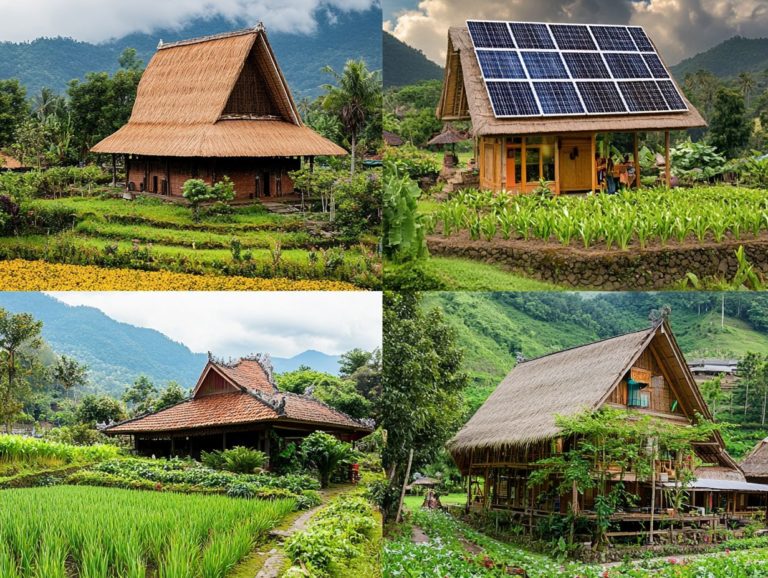Top Sustainable Wine Regions to Explore
Wine enthusiasts and eco-conscious consumers like yourself are increasingly captivated by the realm of sustainable winemaking.
From the verdant vineyards of Europe to the sun-kissed hills of South America, embark on a journey through the premier sustainable wine regions around the globe. Discover the innovative practices that position these areas as leaders in organic and biodynamic farming. Learn about the distinctive flavors and experiences that each region uniquely offers.
Whether you re a seasoned sommelier or just beginning your exploration of the wine world, there s an exciting selection just waiting for you to explore so pour yourself a glass and dive into the finest in sustainable wines!
Contents
- Key Takeaways:
- 1. Organic and Biodynamic Wine Regions
- 2. Sustainable Wine Regions in Europe
- 3. Sustainable Wine Regions in North America
- 4. Sustainable Wine Regions in South America
- 5. Sustainable Wine Regions in Australia and New Zealand
- 6. Sustainable Wine Regions in Africa
- 7. Sustainable Wine Regions in Asia
- 8. Sustainable Wine Regions in the Middle East
- 9. Sustainable Wine Regions in the Caribbean: A Focus on sustainable wine
- 10. Sustainable Wine Regions in Central America: Embracing regenerative practices
- 11. Sustainable Wine Regions in Oceania: A Hub for Eco-Innovation
- 12. Sustainable Wine Regions in Eastern Europe: A Shift Toward Environmental Sustainability
- 13. Sustainable Wine Regions in Scandinavia: Embracing Regenerative Agriculture
- 14. Sustainable Wine Regions in the Pacific Islands: Prioritizing Environmental Integrity
- 15. Sustainable Wine Regions in the United States: The Napa Green Movement
- Frequently Asked Questions: Understanding sustainable wine
- What does it mean for a wine region to be sustainable? Exploring certified sustainable practices.
- What are the top sustainable wine regions to explore? Highlights of sustainable wine regions.
- Why is Napa Valley a leader in sustainable wine? The impact of Napa Green Certified.
- Can you explain the sustainable practices used in Marlborough, New Zealand? A focus on environmental sustainability.
- How does sustainable winemaking benefit the local community? The role of community support and local ecosystems.
- What are some ways to support sustainable wine regions, such as Napa Valley, when exploring them?
Key Takeaways:
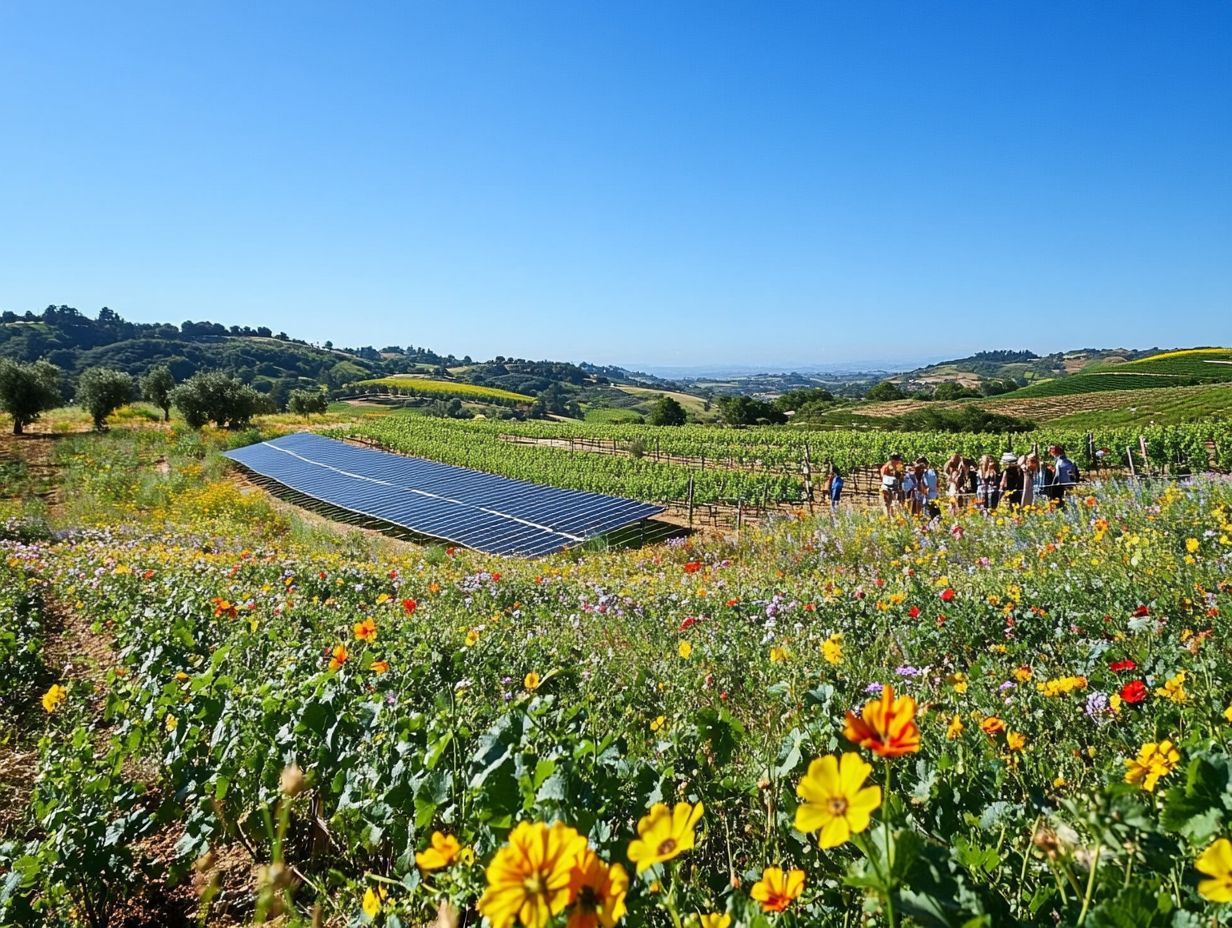
- Explore the world of organic and biodynamic wines in top sustainable wine regions.
- Discover Europe’s diverse and environmentally conscious wine regions.
- North America offers a variety of sustainable wine regions, from California to Canada.
1. Organic and Biodynamic Wine Regions
Organic and biodynamic wine regions like Napa Valley are leading the charge in the sustainable wine movement. Wineries here focus on practices that enhance soil health while employing biodynamic farming, which uses natural methods to promote the vineyard s ecosystem. This produces organic wines that honor both local environments and consumer well-being.
Take Grgich Hills Estate and Joseph Phelps Vineyards, for instance. They exemplify a commitment to environmental sustainability and eco-friendly practices while delivering low-intervention wines that capture the unique characteristics of their location. This alignment with nature makes natural wine increasingly appealing to discerning palates.
At the heart of these practices are principles like composting, which enriches the soil with organic matter, and regenerative agriculture. This approach aims to restore soil health and sequester carbon. Biodiversity is crucial as well; many wineries cultivate various plant species and encourage natural pest predators, fostering a balanced ecosystem.
Benziger Family Winery takes these methodologies a step further by implementing cover crops and practicing crop rotation. These practices enhance soil fertility and contribute significantly to the broader goals of sustainable agriculture.
This harmonious blend of environmental stewardship and winemaking showcases how it s possible to create outstanding products while nurturing a healthier planet.
2. Sustainable Wine Regions in Europe
Europe boasts a wealth of sustainable wine regions that embrace eco-friendly practices, reflecting a commitment to environmental preservation and climate action. These regions engage in sustainable wine production and organic farming.
In places like France s Loire Valley and Italy s Tuscany, you’ll find innovative approaches to vineyard management that enhance grape quality while promoting biodiversity. Practices such as organic composting, cover cropping, and natural pest management thrive, allowing local flora and fauna to flourish alongside the vineyards.
Explore notable wineries like Ch teau de Pommard in Burgundy and Antinori in Tuscany. These establishments invest in renewable energy sources and earn certifications like Demeter and Organic. Such initiatives bolster the ecosystem’s health and set a commendable example for wine producers worldwide.
Join us on this journey and discover which sustainable wine will become your new favorite!
3. Sustainable Wine Regions in North America
North America, particularly Napa Valley, shines with its sustainable wineries actively working to reduce environmental impact. These Napa Green certifications showcase efforts that make your wine choice more responsible while promoting wine tourism through eco-friendly initiatives.
This forward-thinking approach preserves the region s natural beauty and secures the future of the wine industry. Wineries like Stag’s Leap Wine Cellars and Frog’s Leap exemplify this movement by using solar energy, effective water conservation methods, and organic farming.
They seamlessly blend sustainable practices with tourism, offering educational tours that highlight environmentally friendly viticulture. These experiences deepen your appreciation for wine and foster a culture of sustainability that echoes beyond the vineyard gates.
4. Sustainable Wine Regions in South America
South America is stepping into the spotlight as a vital player in sustainable wine production. Wineries are enhancing biodiversity, promoting organic practices, and harnessing renewable energy to keep their carbon footprint minimal.
Countries like Chile and Argentina lead this green revolution. Wineries are embracing minimal interference methods that use native yeast for fermentation while committing to organic farming. In the stunning landscapes of Patagonia and the fertile valleys of Casablanca, local producers focus on soil health and water conservation, crafting resilient ecosystems.
This method creates better wines while protecting the unique tastes of the land. By integrating sustainable practices, these wineries are not just producing exceptional wines; they re also preserving South America s precious natural resources for future generations of wine enthusiasts.
5. Sustainable Wine Regions in Australia and New Zealand
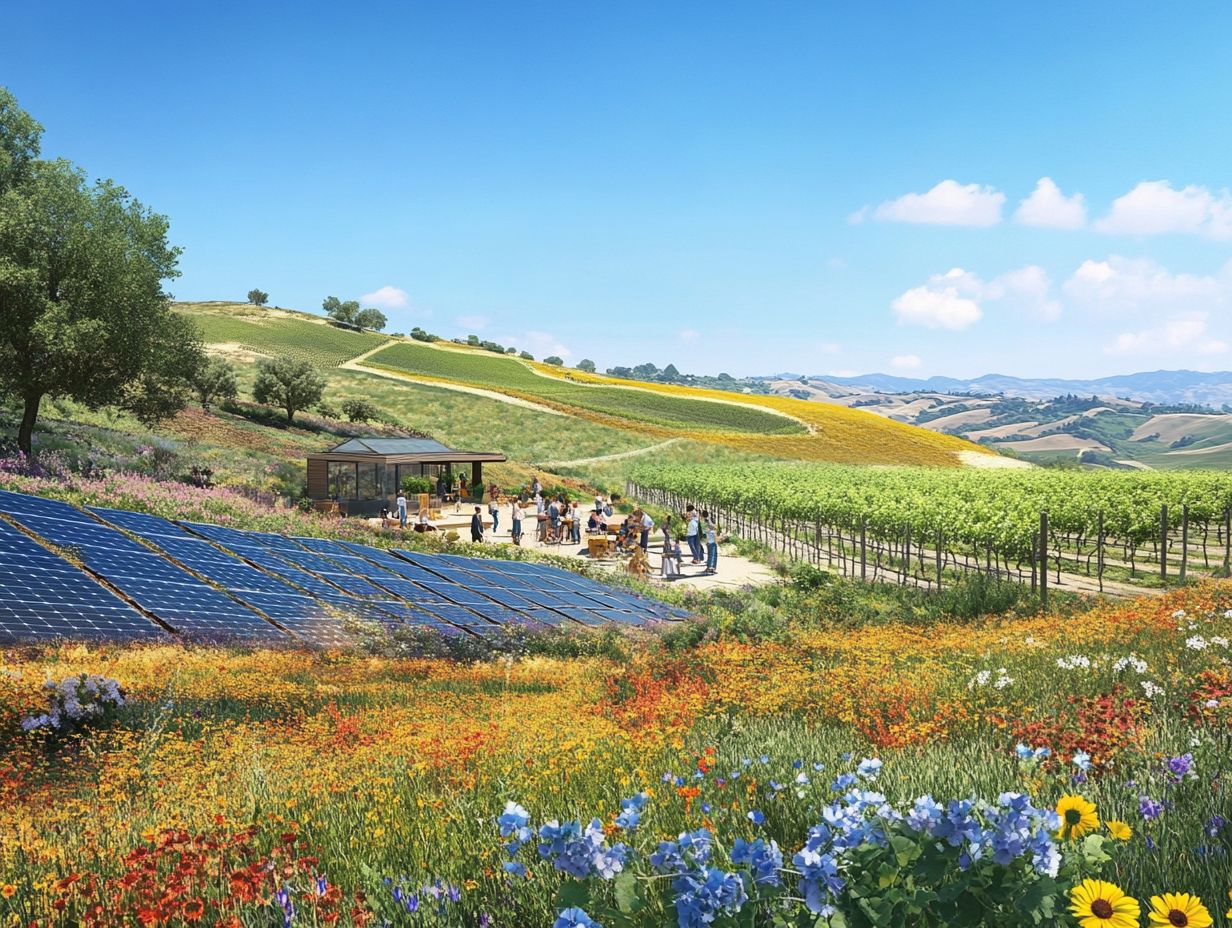
Australia and New Zealand are renowned for their expansive sustainable wine regions. Here, innovative vineyard management techniques and eco-friendly practices significantly reduce carbon emissions and bolster local biodiversity.
Regions like Margaret River in Western Australia and Marlborough in New Zealand exemplify this commitment through diligent practices. Vineyards engage in organic farming, harness renewable energy sources, and implement precision irrigation to minimize water waste. Many of these vineyards proudly hold certifications like LEED, reflecting their unwavering dedication to environmental protection and sustainable development.
By prioritizing eco-innovations, these wineries elevate the quality of their wines while contributing positively to local ecosystems and communities. Join the movement and experience the future of sustainable wine!
6. Sustainable Wine Regions in Africa
Africa is witnessing the rise of sustainable wine regions that are shining examples of organic farming and community support. These areas utilize regenerative practices to promote biodiversity and minimize environmental impact.
Take the Western Cape in South Africa and the Swartland area; they lead the charge, showing how vineyards can flourish in harmony with their natural surroundings.
These regions also foster social equity through community initiatives designed to uplift vineyard workers. Wineries actively provide fair wages, comprehensive training, and educational resources, empowering laborers while promoting environmental stewardship.
Such endeavors ensure that not only is the land preserved, but the communities within these landscapes are enhanced, creating a positive ripple effect that benefits everyone involved. Dive deeper into these regions!
7. Sustainable Wine Regions in Asia
Asia is experiencing a remarkable surge in interest in sustainable wine regions. Wineries are embracing natural farming methods and eco-friendly practices that align with the global push for environmental sustainability.
This evolution elevates the quality of the wines crafted and captivates an expanding audience of environmentally-conscious consumers. Renowned wineries in countries like Japan and China are leading the charge, showcasing innovative harvesting techniques while actively preserving local biodiversity.
Imagine a winery in Japan blending traditional methods with modern organic practices. Meanwhile, a vineyard in China diligently pursues certification through strict adherence to sustainable standards.
These establishments demonstrate that a strong commitment to sustainability can beautifully coexist with exceptional craftsmanship and distinctive regional flavors.
8. Sustainable Wine Regions in the Middle East
The Middle East is stepping into the spotlight in the sustainable wine scene. Wineries are embracing practices that emphasize environmental sustainability, biodiversity, and organic wine production to tackle the region s unique climate challenges.
This transformation is crucial for adapting to the harsh, arid conditions that define much of the landscape. Local winemakers are innovating their techniques with smart watering methods, harnessing solar energy for production, and adopting organic farming practices to reduce chemical usage.
By blending traditional knowledge with modern technology, these wineries cultivate grapes that flourish in the local environment. They also support a healthier ecosystem.
They prioritize soil health and promote biodiversity. This effort is not just redefining the wine industry; it s crucial for addressing pressing climate action issues.
9. Sustainable Wine Regions in the Caribbean: A Focus on sustainable wine
The Caribbean is carving out a distinctive niche in sustainable wine. Innovative wineries are embracing eco-friendly practices that prioritize organic wine production and biodiversity conservation.
These initiatives aim to lessen the environmental impact of viticulture while opening new economic avenues within local communities. Some wineries are harnessing solar energy and employing natural pest control methods, clearly demonstrating their dedication to environmental stewardship.
Prominent producers like Caribe Wine Company lead the charge with organic techniques and engage in reforestation projects. These efforts preserve native ecosystems and foster collaboration between winemakers and local farmers.
This collaboration nurtures a sense of community while promoting sustainable agricultural methods and social equity. Together, they pave the way for a brighter future for both the industry and the environment.
10. Sustainable Wine Regions in Central America: Embracing regenerative practices
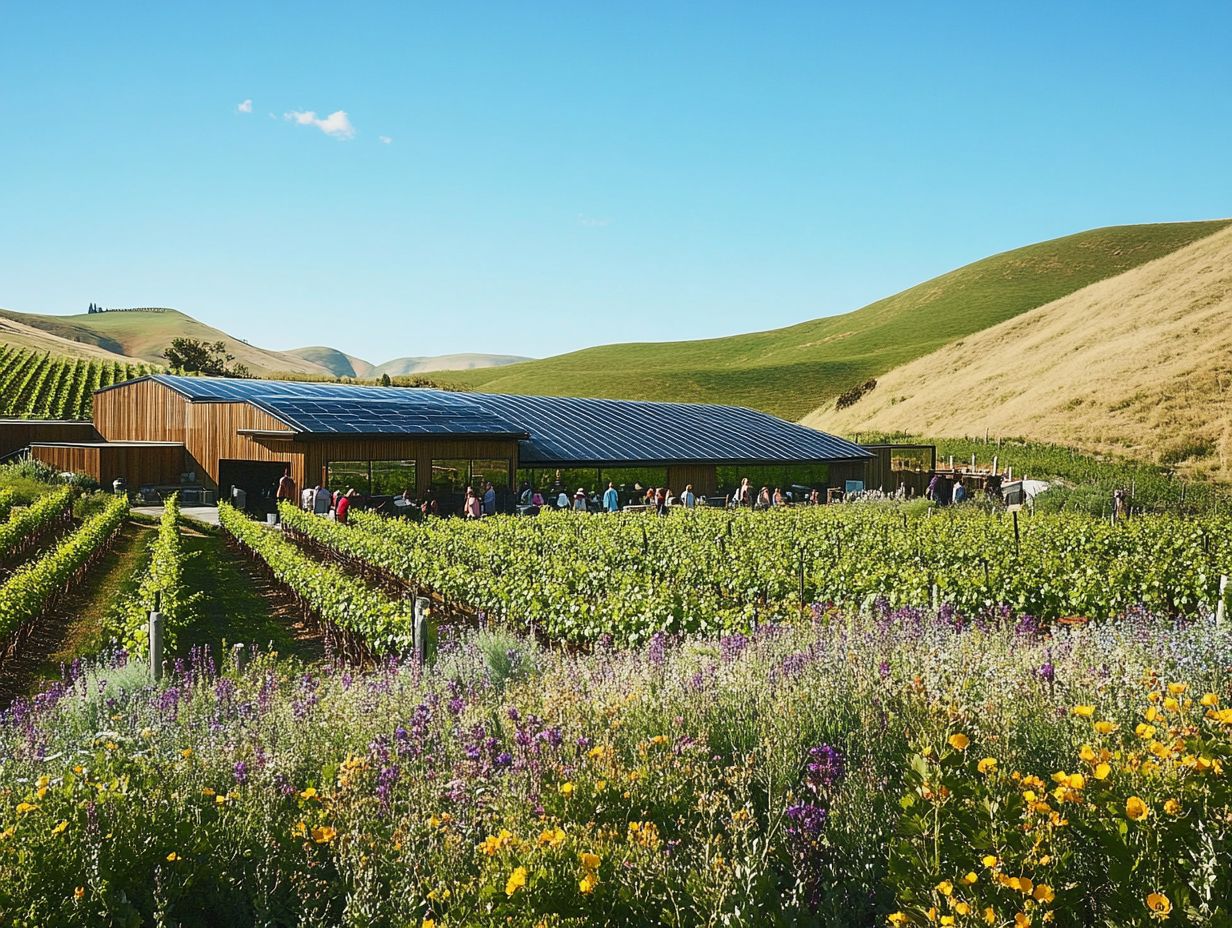
Central America is making its mark in the sustainable wine industry. Wineries are dedicated to natural farming methods and harnessing renewable energy to champion environmental sustainability.
In countries like Costa Rica and Nicaragua, a burgeoning number of vineyards prioritize eco-friendly practices. Many of these wineries embrace permaculture techniques, enriching soil health vital for vineyard ecosystems.
By sourcing locally and minimizing their carbon footprint, they play a crucial role in bolstering the economic well-being of their surrounding communities. They also enhance vineyard management.
Some establishments offer educational programs that equip locals with insights into sustainable agriculture, including biodynamic farming. This fosters a profound connection between the land and its people.
Such efforts showcase the impactful and interconnected nature of sustainable viticulture and its benefits for vineyard workers.
11. Sustainable Wine Regions in Oceania: A Hub for Eco-Innovation
Oceania’s sustainable wine regions stand out for their unwavering commitment to organic wine production and regenerative practices that nurture biodiversity and support community initiatives. These efforts address pressing climate challenges.
In New Zealand’s Marlborough, wineries are embracing cover cropping while significantly reducing chemical inputs through eco-friendly methods. This not only enhances soil health but also fosters a thriving habitat for local fauna. In Australia s Barossa Valley, vineyards increasingly adopt water conservation techniques such as rainwater harvesting and drip irrigation and solar energy solutions, showcasing a remarkable transition toward minimizing their carbon footprint.
These groundbreaking initiatives showcase a thrilling awareness among local producers of their pivotal role in preserving delicate ecosystems. They prove that sustainability and quality wines can indeed coexist in perfect harmony.
12. Sustainable Wine Regions in Eastern Europe: A Shift Toward Environmental Sustainability
Eastern Europe is swiftly emerging as a hub for sustainable wine regions, where wineries embrace organic production methods that prioritize the environment, including methods that help protect and maintain the natural environment and biodiversity.
Countries like Hungary and Romania lead the charge by implementing rigorous organic certifications that ensure environmentally responsible farming techniques and promote positive environmental impact. In Hungary, initiatives like the National Wine Quality Program pave the way for sustainable viticulture. Romania is witnessing a surge in local cooperatives dedicated to eco-friendly practices.
By participating in international certifications like Organic EU and Demeter, along with wine certifications focused on sustainability, these nations are setting themselves apart in the global sustainable wine market. They captivate environmentally conscious consumers eager to support responsible viticulture.
Scandinavia is leading the charge in sustainable wine production, with innovative wineries that prioritize organic practices and community support initiatives. These initiatives enhance biodiversity and minimize environmental impact through energy efficiency.
These vineyards are uniquely equipped to tackle climatic challenges by adopting eco-friendly techniques that promote a healthier environment while bolstering the local economy. Collaborations with nearby communities offer valuable insights into traditional cultivation methods, ensuring that cultural heritage is preserved.
These wineries often become champions of biodiversity, employing practices like intercropping and agroforestry to nurture diverse ecosystems while crafting high-quality wines. This holistic approach elevates the wines themselves and sets a benchmark for other regions aspiring to achieve sustainability.
14. Sustainable Wine Regions in the Pacific Islands: Prioritizing Environmental Integrity
Get ready for an exciting journey in the Pacific Islands as they explore sustainable wine regions, where a commitment to eco-friendly practices and organic wine production aims to preserve the islands’ unique biodiversity and environmental integrity, especially through practices like composting.
As this region garners recognition for its potential in the wine industry, several wineries are emerging, each dedicated to environmentally conscious methods. These establishments craft exquisite wines while tackling the challenges of limited resources and climate fluctuations head-on. Some wineries innovate with water conservation techniques and organic pest management to address unique ecological pressures.
Successfully implementing sustainable practices demands continual adaptation and investment, as cultural traditions blend seamlessly with modern demands, particularly in the context of wine tourism.
Join the movement to support sustainable wine practices and explore these amazing regions that are making a difference!
15. Sustainable Wine Regions in the United States: The Napa Green Movement
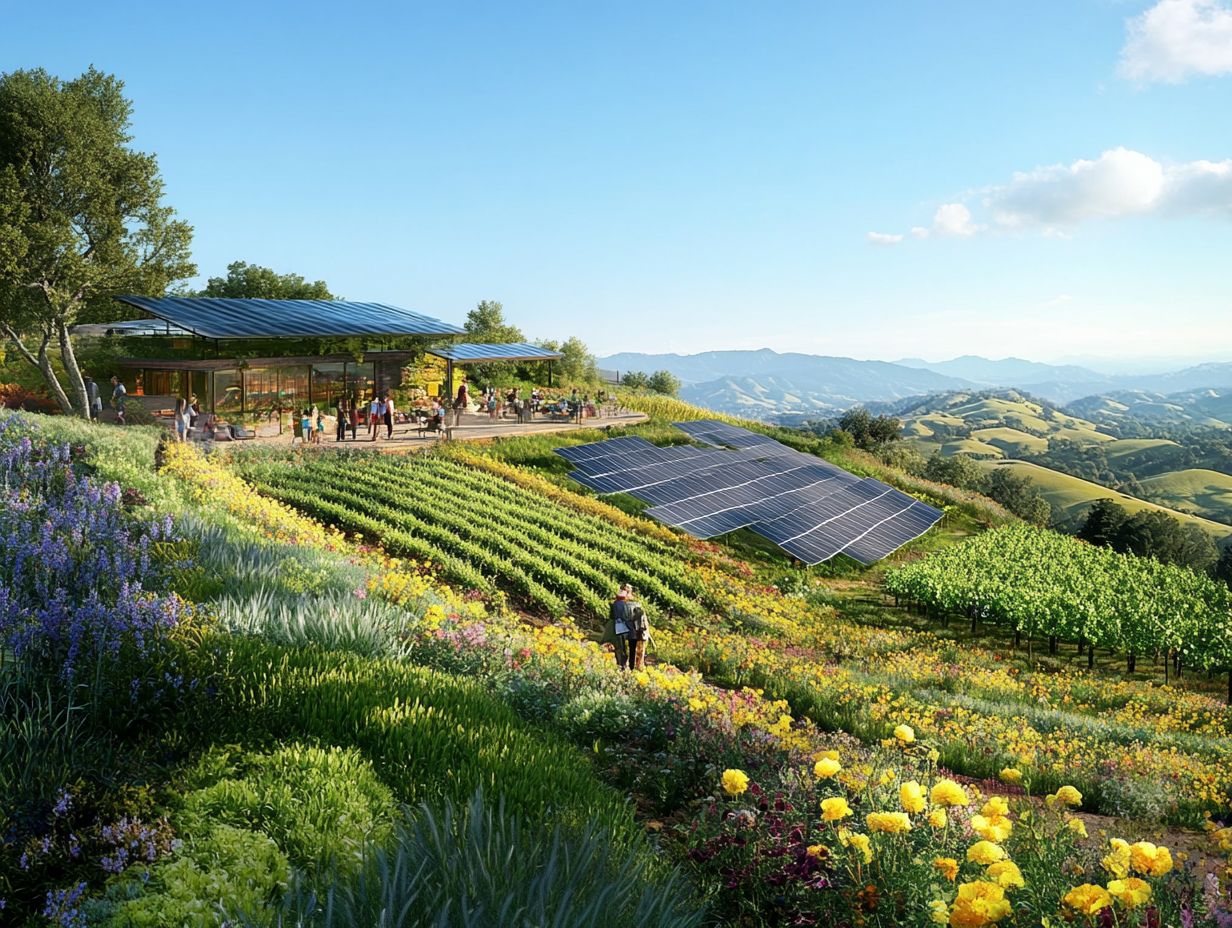
The United States, and Napa Valley in particular, has emerged as a premier destination for sustainable wine production. Wineries are increasingly embracing Napa Green certifications, enhancing their appeal to wine tourists while significantly reducing their environmental footprint. This contributes to the overarching goal of environmental sustainability.
This burgeoning trend reflects a broader commitment to eco-friendly practices that is taking root across the wine industry. Regions like Oregon s Willamette Valley and Sonoma County are not far behind, excitedly adopting similar initiatives and focusing on energy efficiency.
Sustainable wineries are making headlines with their innovative techniques, from water conservation to organic farming and the utilization of renewable energy sources. They are demonstrating their dedication to environmental preservation. For instance, one winery in Sonoma has successfully implemented sophisticated water-saving irrigation systems. Meanwhile, a vineyard in Oregon focuses on using cover crops to boost soil health.
Together, these wineries are not just crafting exceptional wines. They are paving the way for a more sustainable future and inspiring consumers to make environmentally conscious choices that resonate with the mission of sustainable wineries.
Frequently Asked Questions: Understanding sustainable wine
What does it mean for a wine region to be sustainable? Exploring certified sustainable practices.
Sustainable wine regions prioritize environmentally friendly and socially responsible practices in their grape growing and winemaking processes. This includes using organic farming methods, conserving water and energy, and supporting the local community through community support initiatives.
What are the top sustainable wine regions to explore? Highlights of sustainable wine regions.
Some of the top sustainable wine regions to explore include: Napa Valley, California; Marlborough, New Zealand; Tuscany, Italy; Mosel, Germany; Willamette Valley, Oregon; and Mendoza, Argentina. Each is known for its commitment to biodiversity.
Why is Napa Valley a leader in sustainable wine? The impact of Napa Green Certified.
Napa Valley has a long history of sustainable practices. Over 50% of its vineyards are certified organic or use sustainable farming methods. It also has a strong commitment to conservation and renewable energy, making it a leader in sustainability within the wine industry, particularly through the Napa Green Certified program.
Can you explain the sustainable practices used in Marlborough, New Zealand? A focus on environmental sustainability.
Marlborough is known for its commitment to sustainable practices, including using renewable energy sources and conserving water. Wineries implement pest and disease management without harsh chemicals. Many have sustainability certifications that focus on environmental impact reduction.
How does sustainable winemaking benefit the local community? The role of community support and local ecosystems.
Sustainable winemaking goes beyond environmental benefits; it positively impacts the local community. This includes creating jobs and supporting small businesses while preserving the cultural heritage of the region.
What are some ways to support sustainable wine regions, such as Napa Valley, when exploring them?
One way to support sustainable wine regions is by purchasing wines from certified sustainable wineries. You can also visit wineries and participate in tours and tastings to learn about their sustainability practices. Supporting local businesses that prioritize sustainability also makes a positive impact.
Visit these wineries now to experience their sustainability efforts firsthand and make a difference!





